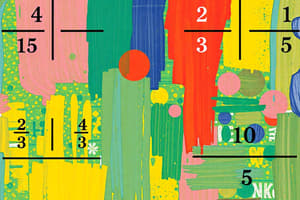Podcast
Questions and Answers
Given two proper fractions, $a/b$ and $c/d$, where $a, c < b, d$ and $b \neq d$, under what precise condition is it impossible to determine which fraction is larger without converting them to a common denominator or decimal form?
Given two proper fractions, $a/b$ and $c/d$, where $a, c < b, d$ and $b \neq d$, under what precise condition is it impossible to determine which fraction is larger without converting them to a common denominator or decimal form?
- When $a/b$ and $c/d$ are part of a Farey sequence of order $max(b, d)$.
- When both fractions are equivalent to $1/2 \pm \epsilon$, where $\epsilon$ is an arbitrarily small positive number.
- When $|ad - bc|$ is less than the least common multiple of $b$ and $d$, compelling nuanced magnitude assessment. (correct)
- When $a + b = c + d$ and both sums are prime numbers.
Consider the infinite series of fractions, $\sum_{n=1}^{\infty} f_n$, where each $f_n$ is a unique proper fraction with a denominator that is a power of 2 (i.e., $f_n = a_n / 2^{k_n}$, $a_n < 2^{k_n}$). What is the highest upper bound this series can converge to, given that no two fractions share the same value?
Consider the infinite series of fractions, $\sum_{n=1}^{\infty} f_n$, where each $f_n$ is a unique proper fraction with a denominator that is a power of 2 (i.e., $f_n = a_n / 2^{k_n}$, $a_n < 2^{k_n}$). What is the highest upper bound this series can converge to, given that no two fractions share the same value?
- Approaches 1, because eventually, every power of two will have a fraction assigned. (correct)
- Converges to $\pi/4$, aligning wth the Leibniz formula’s fractional approximation.
- Upper bound of $e - 2$, reflecting the second shifted exponential base limit.
- Converges to exactly 1, demonstrably achieving complete fractional coverage within assigned constraints.
Given a set $S$ of $n$ distinct unit fractions ($1/a_i$, where $a_i$ are distinct positive integers), what is the tightest upper bound on the smallest possible value of the least common multiple (LCM) of the denominators $a_i$, such that the sum of these unit fractions equals 1?
Given a set $S$ of $n$ distinct unit fractions ($1/a_i$, where $a_i$ are distinct positive integers), what is the tightest upper bound on the smallest possible value of the least common multiple (LCM) of the denominators $a_i$, such that the sum of these unit fractions equals 1?
- The LCM surpasses Landau's function $g(n)$, entailing supreme order selection.
- The LCM must be at least $n!$, reflecting permutation and factorial complexity of denominator combinations.
- The LCM must be greater than $e^{n\gamma}$, tied to Euler's constant, with subtle denominator interactions. (correct)
- The LCM is intricately linked to Szemerédi's theorem, mandating a high degree of arithmetic progression.
In the realm of abstract algebra, consider the set of all proper fractions $a/b$ where $a$ and $b$ are coprime integers and $b$ is less than some integer $n$. If we define an operation $\star$ such that $(a/b) \star (c/d) = (ad + bc) / (bd)$, under what conditions does this set, along with the operation $\star$, form a group?
In the realm of abstract algebra, consider the set of all proper fractions $a/b$ where $a$ and $b$ are coprime integers and $b$ is less than some integer $n$. If we define an operation $\star$ such that $(a/b) \star (c/d) = (ad + bc) / (bd)$, under what conditions does this set, along with the operation $\star$, form a group?
Let $F$ be a field and consider the field of rational functions $F(x)$. If we take a proper fraction $p(x) / q(x)$ in $F(x)$ (where the degree of $p(x)$ is less than the degree of $q(x)$), and $q(x)$ has a complete factorization into distinct linear terms, what method guarantees the unique decomposition of $p(x) / q(x)$ into a sum of partial fractions?
Let $F$ be a field and consider the field of rational functions $F(x)$. If we take a proper fraction $p(x) / q(x)$ in $F(x)$ (where the degree of $p(x)$ is less than the degree of $q(x)$), and $q(x)$ has a complete factorization into distinct linear terms, what method guarantees the unique decomposition of $p(x) / q(x)$ into a sum of partial fractions?
Given a continuous uniform distribution over the interval $[0, 1]$, consider the expected value of the reciprocal of a randomly chosen number $x$ from this interval. If this reciprocal is then expressed as an improper fraction $a/b$, what can be inferred regarding the properties of $a$ and $b$?
Given a continuous uniform distribution over the interval $[0, 1]$, consider the expected value of the reciprocal of a randomly chosen number $x$ from this interval. If this reciprocal is then expressed as an improper fraction $a/b$, what can be inferred regarding the properties of $a$ and $b$?
Consider an iterative process where a proper fraction is repeatedly transformed by adding its numerator to its denominator, creating a new fraction. Formally, $f_{n+1} = a_n / (a_n + b_n)$, where $f_n = a_n / b_n$ is the fraction at the $n$-th step. What is the limit of this fraction as $n$ approaches infinity, assuming $a_0 / b_0$ is a positive proper fraction?
Consider an iterative process where a proper fraction is repeatedly transformed by adding its numerator to its denominator, creating a new fraction. Formally, $f_{n+1} = a_n / (a_n + b_n)$, where $f_n = a_n / b_n$ is the fraction at the $n$-th step. What is the limit of this fraction as $n$ approaches infinity, assuming $a_0 / b_0$ is a positive proper fraction?
In the context of Diophantine equations, consider the equation $1/x + 1/y = a/b$ where $x$, $y$, $a$, and $b$ are positive integers. What conditions on $a$ and $b$ guarantee that there are infinitely many integer solutions for $x$ and $y$?
In the context of Diophantine equations, consider the equation $1/x + 1/y = a/b$ where $x$, $y$, $a$, and $b$ are positive integers. What conditions on $a$ and $b$ guarantee that there are infinitely many integer solutions for $x$ and $y$?
Consider a game where you start with a proper fraction $x_0$ between 0 and 1. In each turn, you are allowed to either add $1/n$ to the numerator or subtract $1/n$ from the denominator (where $n$ is any positive integer), but the fraction must remain proper after each move. What is the optimal strategy to reach a fraction arbitrarily close to 1 in the fewest number of steps?
Consider a game where you start with a proper fraction $x_0$ between 0 and 1. In each turn, you are allowed to either add $1/n$ to the numerator or subtract $1/n$ from the denominator (where $n$ is any positive integer), but the fraction must remain proper after each move. What is the optimal strategy to reach a fraction arbitrarily close to 1 in the fewest number of steps?
Suppose a real number $r$ can be expressed as an infinite continued fraction $[a_0; a_1, a_2, a_3, ...]$ where the $a_i$ are positive integers. If we truncate this continued fraction at the $n$-th term to obtain a rational approximation $p_n/q_n$, and we know that $r$ is an irrational number between 0 and 1, what can be definitively said about the sequence of fractions $p_n/q_n$ as $n$ approaches infinity?
Suppose a real number $r$ can be expressed as an infinite continued fraction $[a_0; a_1, a_2, a_3, ...]$ where the $a_i$ are positive integers. If we truncate this continued fraction at the $n$-th term to obtain a rational approximation $p_n/q_n$, and we know that $r$ is an irrational number between 0 and 1, what can be definitively said about the sequence of fractions $p_n/q_n$ as $n$ approaches infinity?
Flashcards
Proper Fraction
Proper Fraction
A fraction where the numerator is smaller than the denominator.
Improper Fraction
Improper Fraction
A fraction where the numerator is bigger than the denominator.
Mixed Fraction
Mixed Fraction
A fraction consisting of a whole number and a proper fraction.
Equivalent Fractions
Equivalent Fractions
Signup and view all the flashcards
Fraction Equals One
Fraction Equals One
Signup and view all the flashcards
Creating Equivalent Fractions
Creating Equivalent Fractions
Signup and view all the flashcards
Multiplying Fractions
Multiplying Fractions
Signup and view all the flashcards
Multiplying a Fraction by a Whole Number
Multiplying a Fraction by a Whole Number
Signup and view all the flashcards
Study Notes
- This chapter covers various aspects of fractions, expanding on the basics learned in Standard Four.
- It will cover types of fractions
- It will cover comparison of fractions
- It will cover addition and subtraction of fractions with different denominators.
- It will cover how to solve word problems involving fractions
- Competence in fractions is useful for measuring time, budgeting, medical prescriptions, and preparing meals.
Types of Fractions
- Proper Fraction
- A fraction where the numerator is smaller than the denominator.
- Examples: 1/4, 2/4, 1/9, 3/8, 10/12, 15/40
- Improper Fraction
- A fraction where the numerator is bigger than the denominator.
- Examples: 6/5, 9/4, 10/7, 11/9, 12/11
- Mixed Fraction
- A fraction consisting of a whole number and a proper fraction.
- It's obtained when an improper fraction is simplified.
- Examples: 3 1/4, 4 2/2, 5 3/4, 15 1/4, 22 1/3
Equivalent Fractions
- Any fraction where the numerator is the same as the denominator equals 1.
- Example: 2/2 = 3/3 = 4/4 = 5/5 = 6/6 = 1
- Multiplying a fraction by 1 does not change its value.
Comparing Fractions
- Representing fractions with different values with a table shows their various sizes.
- The length of a shaded part represents the size or value of a particular fraction.
- To Identify which fraction is greater in the pair of fractions, compare the fractions in the table to visualise which is smaller.
Adding Fractions with Different Denominators
- Convert fractions to have same denominator by multiplying them Example: 1/2 + 1/4 = 2/4 + 1/4 = 3/4
Multiplication of Fractions with Different Denominators
- The numerators are multiplied to form the new numerator. The denominators are multiplied to form the new denominators.
Studying That Suits You
Use AI to generate personalized quizzes and flashcards to suit your learning preferences.




